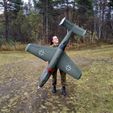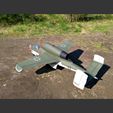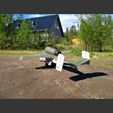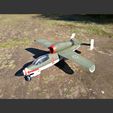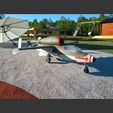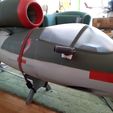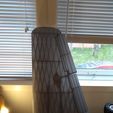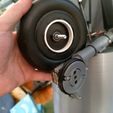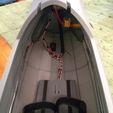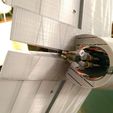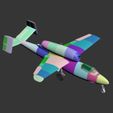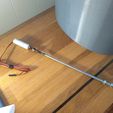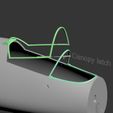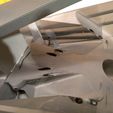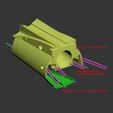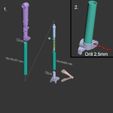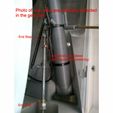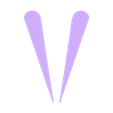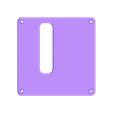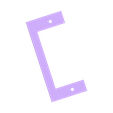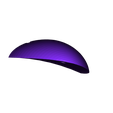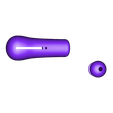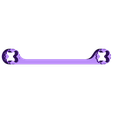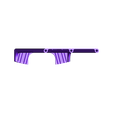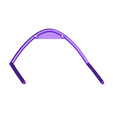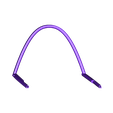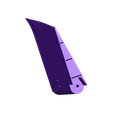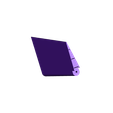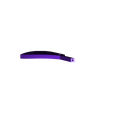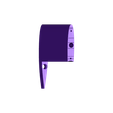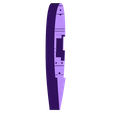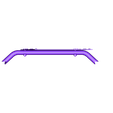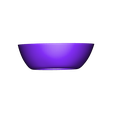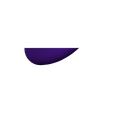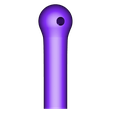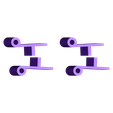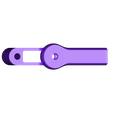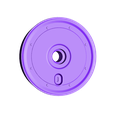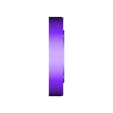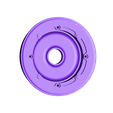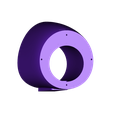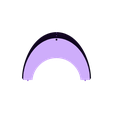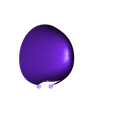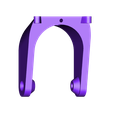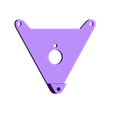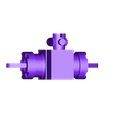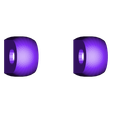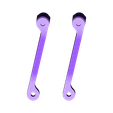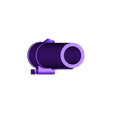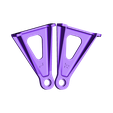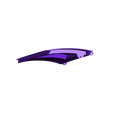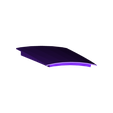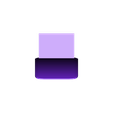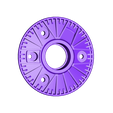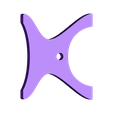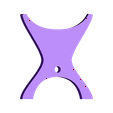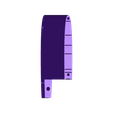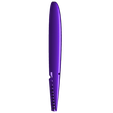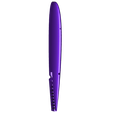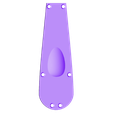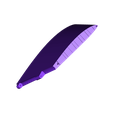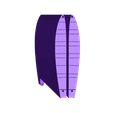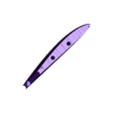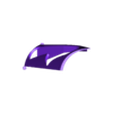PLA is fine for all parts. Your mileage may vary due to temperature requirement and personal preference.
As a weight reference, my Fuselage02 weighs 151 g after the two support pieces are removed.
Open the factory file to see recommended print settings for the some of the parts.
Wings, tail and fuselage main parts should be printed with 0,3 mm wall thickness and single perimeter only. I recommend 0,12 mm layer height. Thicker print width is not recommended due to weight and balance, but 0,4 mm is possible.
The same goes for links and other small critical parts.
EDF impeller and housing should be printed with 6 top and bottom layers and 7 perimeters.
The reason for different processes at different heights on some parts is to either reduce weight by eliminating sloppe zig-zags or to increase strength in certain areas with extra wall thickness for example. If your slices is incapable of making different processes then you either need to change slicer or find your own settings that give a compromise in weigh and strength. These settings were close to the same settings used in Simplify 3D to print the prototypes.
Suggested settings for the thin wall parts without infill:
Aileron01: 0,3 mm single perimeter. 0% infill. 0,12 mm layer height. 6 top and 2 bottom layers.
Aileron02: 0,3 mm single perimeter. 0% infill. 0,12 mm layer height. 6 top and 2 bottom layers.
Aileron03: 0,3 mm 2 perimeter. 0% infill. 0,12 mm layer height. 6 top and 3 bottom layers.
Canopy01: 0,4 mm single perimeter vase mode. 0% infill. 0,24 mm layer height. 0 top and 2 bottom layers.
Canopy02: 0,4 mm single perimeter vase mode. 0% infill. 0,24 mm layer height. 0 top and 2 bottom layers.
Elevator01: 0,3 mm single perimeter. 0% infill. 0,12 mm layer height. 6 top and 3 bottom layers.
Exhaust01: 0,3 mm single perimeter. 0% infill. 0,12 mm layer height. 6 top and 4 bottom layers.
Flap01: 0,3 mm single perimeter. 0% infill. 0,12 mm layer height. 6 top and 3 bottom layers.
Flap02: 0,3 mm single perimeter. 0% infill. 0,12 mm layer height. 8 top and 2 bottom layers.
Flap03: 0,3 mm single perimeter. 0% infill. 0,12 mm layer height. 6 top and 3 bottom layers.
Fuselage01: 0,3 mm single perimeter. 0% infill. 0,12 mm layer height. 8 top and 6 bottom layers.
Fuselage02: 0,3 mm single perimeter. 0% infill. 0,12 mm layer height. 8 top and 4 bottom layers.
Fuselage03 process 1 (0-120 mm height): 0,3 mm single perimeter. 0% infill. 0,12 mm layer height. 6 top and 2 bottom layers.
process 2 (120-145 mm height): 0,3 mm 3 perimeter. 0% infill. 0,12 mm layer height. 6 top and 2 bottom layers.
process 3 (145-end height): 0,3 mm single perimeter. 0% infill. 0,12 mm layer height. 6 top and 2 bottom layers.
Fuselage04 process 1 (0-149 mm height): 0,3 mm single perimeter. 0% infill. 0,12 mm layer height. 10 top and 2 bottom layers.
process 2 (149-297 mm height): 0,3 mm single perimeter. 0% infill. 0,12 mm layer height. 2 top and 2 bottom layers.
process 3 (297-end height): 0,3 mm single perimeter. 0% infill. 0,12 mm layer height. 10 top and 2 bottom layers.
Fuselage04-brace: 0,3 mm single perimeter. 0% infill. 0,12 mm layer height. 6 top and 2 bottom layers.
Fuselage05: 0,3 mm single perimeter. 0% infill. 0,12 mm layer height. 0 top and 2 bottom layers.
Fuselage06 process 1 (0-55 mm height): 0,3 mm single perimeter. 0% infill. 0,12 mm layer height. 6 top and 2 bottom layers.
process 2 (149-297 mm height): 0,3 mm single perimeter. 0% infill. 0,12 mm layer height. 0 top and 0 bottom layers.
Fuselage07: 0,3 mm single perimeter. 0% infill. 0,12 mm layer height. 6 top and 6 bottom layers.
Hstab01: 0,3 mm single perimeter. 0% infill. 0,12 mm layer height. 8 top and 4 bottom layers.
Hstab02 process 1 (0-25 mm height): 0,3 mm single perimeter. 0% infill. 0,12 mm layer height. 6 top and 3 bottom layers.
process 2 (25-30 mm height): 0,3 mm single perimeter. 0% infill. 0,12 mm layer height. 12 top and 12 bottom layers.
process 3 (30-end height): 0,3 mm single perimeter. 0% infill. 0,12 mm layer height. 6 top and 3 bottom layers.
Intake01: 0,3 mm single perimeter. 0% infill. 0,12 mm layer height. 10 top and 2 bottom layers.
Nacelle01: 0,3 mm single perimeter. 0% infill. 0,12 mm layer height. 8 top and 2 bottom layers.
Nacelle02: 0,3 mm single perimeter. 0% infill. 0,12 mm layer height. 6 top and 2 bottom layers.
Nacelle03 process 1 (0-10 mm height): 0,3 mm single perimeter. 0% infill. 0,12 mm layer height. 8 top and 4 bottom layers.
process 2 (10-180 mm height): 0,3 mm single perimeter. 0% infill. 0,12 mm layer height. 0 top and 0 bottom layers.
process 3 (180-end height): 0,3 mm single perimeter. 0% infill. 0,12 mm layer height. 8 top and 4 bottom layers.
Nacelle04: 0,3 mm single perimeter. 0% infill. 0,12 mm layer height. 6 top and 4 bottom layers.
Rudder01: 0,3 mm single perimeter. 0% infill. 0,12 mm layer height. 7 top and 3 bottom layers.
Rudder02: 0,3 mm single perimeter. 0% infill. 0,12 mm layer height. 7 top and 3 bottom layers.
Vstab01: 0,3 mm single perimeter. 0% infill. 0,12 mm layer height. 6 top and 3 bottom layers.
Vstab02: 0,3 mm single perimeter. 0% infill. 0,12 mm layer height. 6 top and 3 bottom layers.
Vstab03 process 1 (0-14 mm height): 0,3 mm single perimeter. 0% infill. 0,12 mm layer height. 6 top and 2 bottom layers.
process 2 (14-18 mm height): 0,3 mm single perimeter. 0% infill. 0,12 mm layer height. 6 top and 6 bottom layers.
process 3 (18-end height): 0,3 mm single perimeter. 0% infill. 0,12 mm layer height. 4 top and 0 bottom layers.
Wing01: 0,3 mm single perimeter. 0% infill. 0,12 mm layer height. 6 top and 6 bottom layers.
Wing02: 0,3 mm single perimeter. 0% infill. 0,12 mm layer height. 6 top and 6 bottom layers.
Wing03: 0,3 mm single perimeter. 0% infill. 0,12 mm layer height. 6 top and 2 bottom layers.
Wingtip01: 0,4 mm single perimeter. 0% infill. 0,12 mm layer height. 2 top and 2 bottom layers.
Other parts:
Nose01: 0,4 mm 2 perimeter. 0% infill. 0,12 mm layer height. 6 top and 6 bottom layers.
Canopyframe01: 0,48 mm 3 perimeter. 0% infill. 0,12 mm layer height. 6 top and 6 bottom layers.
Maintire01: 0,34 mm 2 perimeter. 7% infill. 0,12 mm layer height. 8 top and 4 bottom layers.
Mainwheel02: 0,3 mm 2 perimeter. 7% infill. 0,12 mm layer height. 8 top and 3 bottom layers.
Wingjoiner01: 0,35 mm 6 perimeter. 0% infill. 0,12 mm layer height. 13 top and 13 bottom layers.
High strength parts like landing gear struts and similar should be near solid, with four or more perimeters and higher than normal temp.

/https://fbi.cults3d.com/uploaders/12943812/illustration-file/53d44e0d-7b64-4b72-8f97-3a7df239c305/HE-162-92.jpg)









































































































